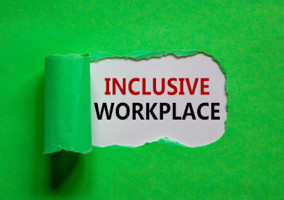You care about sharing your organisation’s work and make the case for improving communications every day. But are you still excluding 15% of your audience?
I’ve worked at Sightsavers for more than 20 years, and as a person with lived experience of a disability, I have dedicated some of my time to improving the experiences of our staff with disabilities.
In 2016 we launched our Disability Inclusion Working Group, aiming to make us an employer of choice for people with disabilities, promote staff commitment to inclusion and monitor how well we’re doing.
I’ve learned a lot along the way so was excited to be asked to share this with CharityComms in their new guide to making comms more accessible - Accessible communication: A starting point to foster more inclusive comms. As the saying goes: ‘nothing about us, without us.’
Communications can exclude someone with a disability
It is estimated that one in seven people in the world have some form of disability, experiencing impaired vision, hearing, movement, memory or thinking. Many others contend with specific learning difficulties. All these people have a right to enjoy life opportunities and participate in society, just like anyone else.
Take Fama, in Senegal, for example. She is 48 years old, lives with her children, her daughters-in-law, and a co-wife. She earns money by occasionally trading goods. She is also blind and the vice president of an organisation of and for blind people. She heard about the country’s Covid-19 vaccination programme on the radio but found it difficult to get more information.
“Apart from the radio news, I was unable to access other types of information. As a blind person, I have no other sources of information. Even the link to register [for the vaccine], I only learned about it recently and it is an obstacle because how could I use it if nothing is provided for people like me?”
Failing to include people clearly has consequences. It's time to make a conscious decision to design a world for everyone, regardless of their ability. No one should be excluded from your communications.
Different needs require different solutions
The scope of people’s different needs is wide and might not be obvious straight away. Someone’s requirements and preferences could range from sight and hearing support needs to motor and cognitive considerations.
Inclusive communications are about respecting and understanding that people’s ability to access and process messages is as varied as they are. It's time to think about alternative ways for people to access your messages.
I know from experience that getting started can feel overwhelming. The most important thing is to start. Accept that you’re going to make some mistakes along the way but remember that each step you take is a move in the right direction. At the end of the day these changes benefit everyone; choices open more doors for everyone.
The journey towards inclusivity
Here are five questions to ask yourself as you begin your journey.
1. As a comms expert you understand the power of representation but how are you representing people with lived experience of disability in your comms? How are you listening to and including their lived experience to inform your work?
Setting up and working with an internal inclusion group is a very helpful way to get to grips with accessibility. We have a Disabled Employee Network which enables staff with disabilities to share and discuss their experiences. Meanwhile our Disability Inclusion Group has been invaluable, with different members contributing to specific projects depending on their other work priorities, strengths and interests. Our media officer for inclusion, Tess, describes the group as indispensable because it gives her both inspiration for, and confidence in, her work.
2. Are you putting the needs of people with disability front and centre of your work?
RNID share a great example in the new guide of learning from their supporter’s communication needs. They were asked for something visual which people could use in public places to show staff that they couldn’t hear and highlight how to make communication easier. In the process of creating it, they discovered that the more people used it, the more options they needed to include. There is no ‘one size fits all’ in inclusive communications. The result is a fully customisable comms card which is empowering to both the card holder and the person to who it’s being shown.
Then there are some very practical things to consider:
3. How will what you’ve produced work with a screen reader?
4. Are you putting accessibility first when you look at alt text, colour contrast, subtitles and captioning?
5. Are you applying this across all your platforms: on your website, in all your social posts, in print and at meetings?
'Lets make sure no one gets left behind'
At Sightsavers we have a small team responsible for testing our products including web content, documents and presentations to make sure they are accessible.
Most importantly, never stop learning. I know I never will. The CharityComms guide has been designed to steer and support you as you get started and help you find more resources as you need them.
If you work in communications, you may have a better idea than most about the dangers of excluding particular groups. Everyone should be able to seek and access help from your organisation. We know the power of communications to bring people together. Let’s use our skills effectively and make sure that no one gets left behind or excluded by our work.
You can read CharityComms accessible communications guide here.
Kate Bennell is disability inclusion coordinator at Sightsavers UK
Related articles












